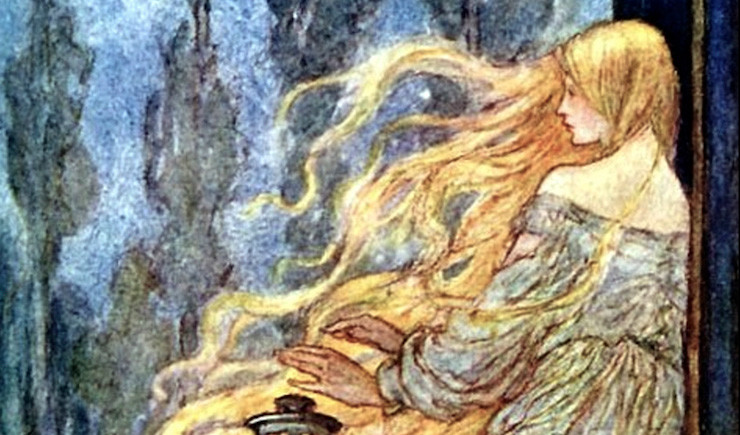Stories of maidens locked into towers or behind walls litter European folklore, appearing in fairy tales, saints’ lives, and dubious histories and chronicles. In part, these tales echoed the real life experiences of women locked behind walls for one reason or another. Some women went willingly. Convent life, for instance, could offer not just a religious experience and spiritual comfort, but educational and artistic opportunities for many women. Other women did not.
But even the strictest convents and prisons did not completely remove these women from the world of men. Not even in the case of arguably the most famous fictional woman to be trapped in a tower, Rapunzel.
“Rapunzel” was collected by the Grimms for their first edition of Children and Household Tales, initially published in 1812. Like “Little Briar Rose,” it is another tale that came to the Grimms through the French aristocracy, in this case through the story “Parslinette,” published by Charlotte-Rose de Caumont de La Force in 1697. The daughter of a marquis, she was the protégé of one of Louis XIV’s mistresses, Madame de Maintenon, who would later, very secretly, marry Louis XIV. De La Force used this relationship to become a maid of honor first to the queen and later to the dauphine of France. As a maid of honor, she proceeded to have multiple love affairs, and a marriage with a very much younger man that his shocked family managed to have annulled—even though the marriage had been approved by the king himself.
In between the multiple love affairs, she wrote violent and sexy historical romances, published to great acclaim, fairy tales, and poems primly described as “impious.” They were too impious for Louis XIV, who ignored de La Force’s relationship with his mistress and sent the author to a convent. Trapped behind walls, she continued to write. “Parslinette” was one of the first stories she penned behind convent walls.
“Parslinette” is a story of forbidden desire. It starts with the story of a woman craving the parsley that grows in a fairy’s garden, and can be found nowhere else—de la Force assures us that the parsley in question is extremely delectable. Her husband sneaks into the garden through a door that just happens to be open for a moment. When he is—inevitably—discovered, the only thing that the fairy will accept in payment for the stolen parsley is his child. It’s both a familiar folktale motif, from a tale that de La Force almost certainly heard as a child, and a reflection of the reality de la Force knew all too well: walled off gardens, foods restricted to the powerful who lived behind those walls, and punishments far outweighing the original offense.
Buy the Book


Over the Woodward Wall
The fairy takes the child and walls her away in a tower—another reflection of a historical reality de la Force, who had watched children, legitimate and illegitimate, taken from mothers and hidden away in convents or in secret homes, knew all too well. It was exactly how her own mentor, Madame de Maintenon, had come to the attention of Louis XIV—as one of the discreet governesses of his illegitimate children. It’s a delightful life, filled with luxuries, and Parslinette is never bored or lonely, but happy. That is, until a prince overhears her singing voice, and comes to the tower.
She’s terrified. To quote from Jack Zipes’ translation:
…for she remembered that she had heard there were men who could kill with their eyes, and this man’s looks were very dangerous.
She does not let him in. It’s important, I think, to note at this point that although Parslinette has spent her life locked away in a tower, she’s not completely naïve or uneducated: the text makes a point of telling us that she reads, a lot. It’s possible that she heard this from the fairy, but the fairy has mostly left her alone in the tower. It’s equally possible that she learned this in a book.
It gets a bit worse. The prince tricks his way up into the tower:
Then he bowed down before Parslinette and embraced her knees with ardor, to persuade her of his love. But she was afraid.
Well, maybe if you hadn’t gone directly for her legs, dude. Or said “Bonjour!” first. Either way.
In any case, they are married—well, sorta—in the next few sentences. I say sorta because the only two people present for this “wedding” are the prince and Parslinette, which leads me to the suspicion that just possibly this ceremony was not all that legal. Or religious. She quickly becomes pregnant:
Since she had no idea what her condition signified, she was upset. Although the prince knew, he did not want to explain it to her for fear of frightening her.
Ok, so maybe she didn’t learn all that much from books.
Also, dude! What’s better, scaring her a bit now, or, you know, LETTING HER KNOW THAT A SMALL HUNGRY CHILD WILL BE PART OF HER LIFE IN A FEW MONTHS?
Anyway. Her pregnancy gets Parslinette kicked out of the tower—in yet another echo of real life experiences that de La Force had personally witnessed: women driven from luxurious homes after becoming pregnant illicitly, giving birth behind convent walls, in secret homes, in distant towns, or even in the streets.
The fairy also makes the prince throw himself off the top of the tower (yay!) which makes him go blind (hmm). This doesn’t do quite as much to keep him from Parslinette as I was kinda hoping; after various adventures that at least do include turning him into stone (and then, alas, turn him back into a human), he, Parslinette and their twin kids end up back in his father’s palace and live happily ever after—this, despite the fact that Parslinette is not a princess, or even, apparently, of noble birth.
That, too, was something de La Force has personally witnessed—a secret wedding between a king and a woman of non-royal birth. Which is to say, for a so-called fairy tale, “Parslinette” is oddly grounded in reality—even if one of its major characters is a fairy.
That very reality was to give the Grimms a bit of trouble when they collected the tale a little over one hundred years later, apparently unaware that their “Rapunzel” was nothing more than an abridged version of de La Force’s stylish literary tale. It’s impossible to know for sure, but given that the Grimms were primarily interested in preserving German culture, it seems unlikely that they would have bothered to preserve—and later clean up –a story from France. And yet, that’s basically what the version of “Rapunzel” in the first edition of Grimms’ Household Tales is. A few elements have been changed—the mother now wants rapunzel, instead of parsley, giving the protagonist a different name, and the list of luxuries that Parslinette enjoys in her tower, as well as that important note about her education, is gone. As is the bit where the prince briefly turns into stone, sigh. But otherwise, everything is the same: the mother longing for a green plant from a fairy garden; her husband getting that plant; the girl locked in the tower and letting down her hair to let the prince up; the angry fairy tossing him from the tower, causing him to lose his eyesight; the twins, the happy ending.
And oh, yes, that pregnancy.
The Grimm brothers kept the pregnancy, and Rapunzel’s confusion about it, in that first edition of Household Tales—an edition not meant for children. Children apparently read it anyway (go, kids, go!) and subsequent editions took out many of the elements deemed objectionable.
Including illicit pregnancies.
In later editions, the Grimms did take the opportunity to add one bit of explanatory detail: in their retelling, the prince loses his eyesight because he just happened to fall on some thorns. Their other changes, however, focused on making the story more “suitable” for children and more “German,” and meant that by the seventh edition (1857), their version could be kindly called “confused.” For instance, the text alternatively describes the antagonist as both a “fairy” (a creature from French folklore, not the German folklore the Grimms wanted to emphasize), and a “sorceress” (considerably scarier, and also, not a French fairy.) The terms aren’t too far off, but where the original French story focused on the enchantments and luxuries available to the enclosed Parslinette, the Grimm version focuses on the entrapment and isolation, transforming the somewhat more ambiguous figure of the French tale into a figure of evil.
Rapunzel no longer asks the fairy, or the witch, why her clothes are suddenly tight; she instead asks the witch why she is so much harder to pull up than the prince. In the first version, of course, no one has bothered to tell her anything about pregnancy. In the second version, Rapunzel looks at best careless and at worst lacking all common sense. If she’d been established as someone who speaks without thinking, it might have worked. But the story has no indication of that: we’re instead left to assume that Rapunzel is a bit of an airhead. Or that her hair has just dragged all common sense out of her. Whichever. Her twins appear literally out of nowhere in the final two sentences of the story.
This was the version Andrew Lang turned to as he began collecting the stories for The Red Fairy Book (1890). His version removed the twins entirely, and cleared up the confusing references to fairy and sorceress, instead using “witch.” This became the most familiar version to English readers, although readers can also find translations of both the French version and various Grimm versions.
But the power of the tale, I think, in whatever version, comes not from the name of the protagonist, or Rapunzel’s pregnancy, or even the image of Rapunzel letting her golden hair drape down from a tiny window in her tower. Rather, it’s the way that all versions, from French to English, reflect a very real historical circumstance: women who, for one reason or another retreated behind stone walls and into towers, voluntarily and involuntarily. That Parslinette/Rapunzel just happens to retreat into a tower (often used as a phallic symbol) guarded by a woman only adds to this power.
Originally published in June 2016 as part of the Disney Read-Watch.
Find Mari’s essay on Tangled, the Disney adaptation of Rapunzel, here.
Mari Ness lives in central Florida.










